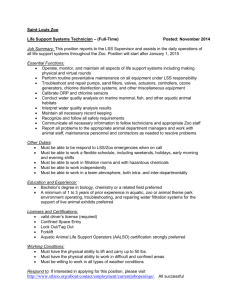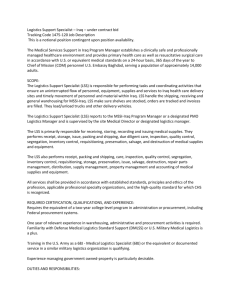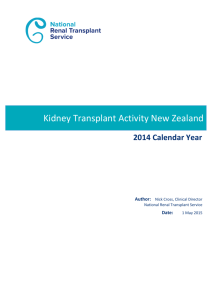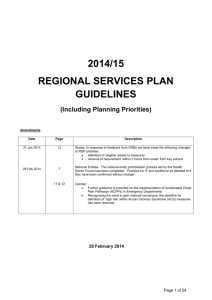ASMS Laboratory Submission
advertisement
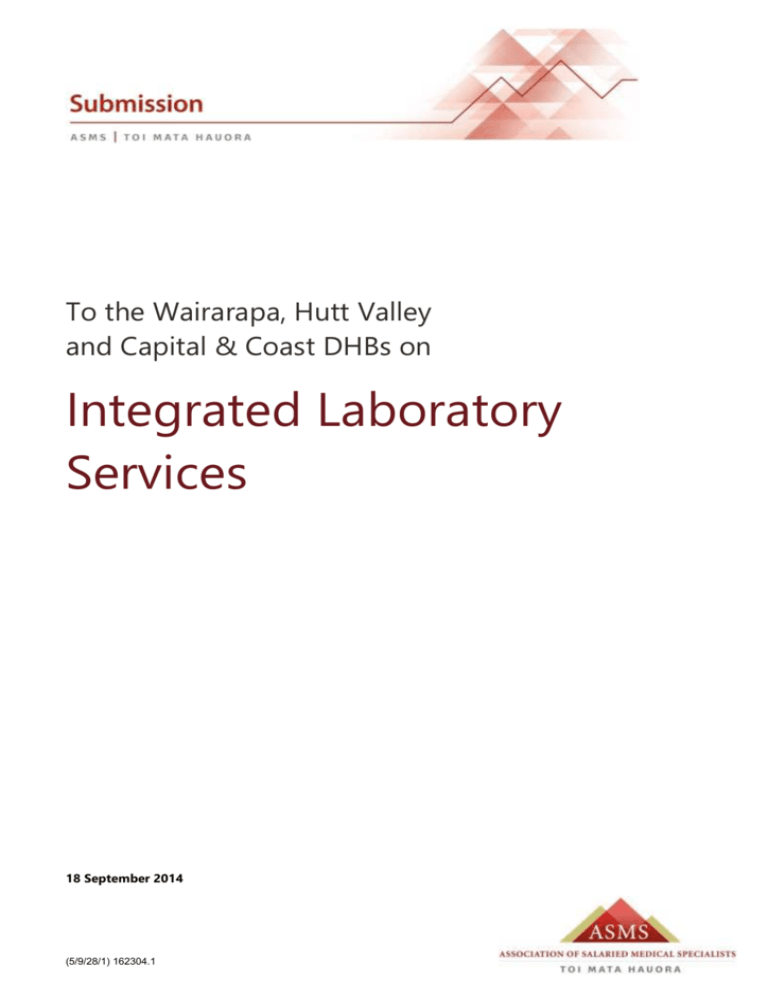
To the Wairarapa, Hutt Valley and Capital & Coast DHBs on Integrated Laboratory Services 18 September 2014 (5/9/28/1) 162304.1 INTRODUCTION 1.1 The Association of Salaried Medical Specialists (ASMS): Toi Mata Hauora represents salaried senior doctors and dentists. The Association was formed in 1989 to advocate and promote the common industrial and professional interests of salaried senior doctors and dentists. The Association has more than 4,000 members, most of whom are employed by District Health Boards (DHBs) as medical and dental specialists such as psychiatrists, anaesthetists, surgeons, oncologists and paediatricians. About 90% of senior doctors and dentists employed in public hospitals and other services provided by DHBs are members of the Association. 1.2 Most of the Association’s members are covered by a multi-employer collective agreement (MECA) between the country’s 20 DHBs and the Association (the ASMS DHB MECA). We also negotiate a number of very much smaller collective agreements, including two multiemployer collective agreements (one covering senior doctors employed at hospices and one covering general practitioners employed in union health centres in the lower North Island). 1.3 Though our relationship with the employers of our members has inevitably involved some differences, the Employment Relations Act has proved a good framework for systematically working through sometimes very difficult issues for our members who form a crucial part of the New Zealand public health system. With our members’ employers and with successive governments we have tried to build a system in which senior doctors and dentists participate in shaping the public health service for the benefit of patients and the nation. ASMS Submission 3 SUMMARY 1. The stated main aim of the proposal is that hospital and community laboratory services are ‘integrated’, with two options presented: (1) a partnering arrangement between a private laboratory and DHBs, and (2) a single (private) laboratory provider. 2. Potentially both options involve forms of privatisation of publicly provided services and transfer of the staff of a critical service to a third party. If either form of privatisation proceeds, it will be the first privatisation of a public hospital service since 2008. 3. The proposal process falls well short of the engagement obligations of the DHBs under the national multi-collective employment agreement – MECA (including Clause 2 with particular reference to the second bullet point), the Time for Quality agreement between the Association and the DHBs (including the engagement principles), and the Government’s policy advice on clinical leadership, In Good Hands. 4. The proposals fail to appreciate three significant factors: a. the high risk of destabilising the hospital laboratory staff (including specialists), which is already vulnerable. b. the high integrated dependence of secondary and tertiary services on the hospital laboratories – about 70% of clinical decision-making depends on the work of these laboratories. c. the importance, in respect of patient safety and quality of care, of the integration between hospital testing and the DHBs’ secondary and tertiary users of this testing. 5. The Association supports neither option but would support an alternative option: an enhanced status quo, including a shared data repository, as discussed in the Laboratory Services Strategy (LSS), and cooperative working and professional relationships with the provider of community testing consistent with the principles of ‘alliancing’. This does not involve transferring hospital laboratory staff to a new employer. 6. Current laboratory services are not ‘broke’ and do not need ‘fixing’, the proposed options are high risks, the evidence that either of the two options would improve the effectiveness and efficiency of services is not presented, and there is a lot of uncertainty about what the proposals mean in practice. 7. The DHBs’ own work has shown the sub-region’s laboratory services are overall working well and requires only some ‘fine tuning’. The clear message from clinicians is that ‘overwhelmingly’ most of the areas where services could be improved revolve around the ability to access test results at the point of physician consultation and that this could only be fixed if a shared data repository is introduced. This was seen as the ‘lynch pin’ of integration. 4 Integrated Laboratory Services 8. The risks associated with the two management and ownership options in the DHBs’ proposal are considerable, including a real risk of losing staff in a service that already faces challenges in retention and recruitment. The DHBs could also lose control of what is a core service within the whole public health service, which could lead to substantial extra costs downstream and have a negative impact on wider DHB services. 9. The proposal lacks clarity in many areas and raises more questions than answers. 10. An enhanced status quo, including the development of a shared data repository and cooperative working and professional relationships, would be a relatively risk-free alternative while evidently addressing the main issues identified by the working group. In the meantime there is an opportunity to extend and fine-tune contracts with the aim of improving integration over time. This approach is the clear message sitting behind the LSS report. 11. The Association recommends that the DHBs review their process in order to (a) confirm that hospital laboratories will continue to be publicly provided and their staff DHB employed and (b) work with the Association in development a process for clinical leadership in the development of a more integrated relationship between the hospital laboratories and between them and the community testing provider based on enhanced collaboration. ASMS Submission 5 PROPOSAL ON INTEGRATED LABORATORY SERVICES The Association has not had the opportunity to make as full a submission on this important issue as we would have preferred, due to the tight timeframe. Further, the proposal process falls well short of the engagement obligations expected of DHBs under the national multi-collective employment agreement – MECA (including Clause 2 with particular reference to the second bullet point), the Time for Quality agreement between the Association and the DHBs (including the engagement principles), and the Government’s policy advice on clinical leadership, In Good Hands. The proposals fail to appreciate three significant factors: 1. The high risk of destabilising the hospital laboratory staff (including specialists), a workforce which is already vulnerable. 2. The high integrated dependence of secondary and tertiary services on the hospital laboratories – about 70% of clinical decision-making depends on the work of these laboratories. 3. While improving integration between hospital and community testing is important, of greater importance in respect of patient safety and quality of care is the integration between hospital testing and the DHBs’ secondary and tertiary users of this testing. The proposal’s main aim is that hospital and community laboratory services are ‘integrated… into a seamless service for referrers and patients, as this is where the largest clinical and financial gains will be made’. PROPOSED OWNERSHIP OPTIONS Just two options are presented: 1. a partnering arrangement between a private laboratory and DHBs; and 2. a single laboratory provider. It is clear from the consultation document that the second option would involve a private provider. Potentially both options involve forms of privatisation of publicly provided services and transfer of the staff of a critical service to a third party. If either form of privatisation proceeds, it will be the first privatisation of a public hospital service since 2008. It is opposite to the direction taken by, for example, the three Auckland DHBs, and Waikato and Canterbury DHBs when they have reviewed their community testing contracts in recent years. The Association believes there is a third option which would provide a better and more sustainable future for laboratory services, and advises you to consider this, subject to the outcome of a new process based on genuine clinical leadership: 6 Integrated Laboratory Services 3. Enhanced status quo, including a shared data repository, as discussed in the Laboratory Services Strategy (LSS) and cooperative working and professional relationships with the provider of community testing consistent with the principles of ‘alliancing’. This does not involve transferring hospital laboratory staff to a new employer or placing hospital laboratory decision under the control or influence of a private company either through a single provider or joint venture. While there are important issues to address such as improving the collaboration between the Capital & Coast and Hutt Valley hospital laboratories and enhancing collaboration between these laboratories and the community testing provider, current laboratory services are not ‘broke’ and do not need ‘fixing’, especially by the drastic nature of the two options currently proposed. These options are high risk, the evidence that either of them would improve the effectiveness and efficiency of services is not presented, and there is a lot of uncertainty about what they will mean in practice. To elaborate: Current services merely need fine-tuning The LSS states: The current state of service provision is relatively strong. There are no pressing issues in service delivery. Growth in testing volumes has slowed considerably although there have been material price increases in laboratory costs. There are further areas of refinement, for instance, in laboratory standardisation (all of which would be resolved by a data repository), but much has been done. There is partial IT integration only (p30). And later in the LSS report: Overall, stakeholders reported that the current provision of laboratory services in the region works reasonably well. However, certain services need to be ‘fine tuned’ to achieve efficiency gains… (p 68, LSS). The ‘fine tuning’ includes ‘overwhelmingly’ the need for a data repository that is accessible to all relevant clinicians across the sub-region. Developing a common platform for sharing information is seen as a ‘lynch pin’ of integration (p 76, LSS). It is recommended as ‘Priority 1’ and ‘needs to be acted on immediately’. It is seen as invaluable in reducing medical error, avoiding waste and duplication of tests and improving the quality and timeliness of care to patients. RISKS IN THE DHBs’ PROPOSED OPTIONS Partnership option The consultation itself acknowledges potentially significant risks: more complex to operate due to potentially different goals and interests of DHBs and private provider. ASMS Submission 7 more difficult to implement due to melding of laboratory processes and structures. risks shared by all partners; for example, in a capped price contract, if demand rises, then increased costs are borne by provider. accountability clearer than an alliance but there is still potential for non-delivery of some key outcomes in strategy. joint venture with DHBs requires approval from the Minister, which adds complexity to the process. staff employment arrangements may change depending on the partnership model. With regard to the last point above, there is an international shortage of laboratory-based specialists and, as acknowledged in the LSS, laboratories are ‘facing the challenge to manage an ageing workforce and will have to develop strategies to keep productive and highly specialised staff working longer’. This is a particularly vulnerable workforce. Any real or perceived disadvantages from a change in employment arrangements may well lead to a loss of these staff. People may also decide to leave if the new service arrangements create difficulties in day-to-day practice. Any loss of even a small number of staff could have a major impact on the effective delivery of services. There will be additional risks, depending on the yet-to-be-determined detail of what is being proposed. The consultation document points out, for example, that under a partnering arrangement services can be subcontracted to other providers, which entail risks related to lack of control and a loss of key competencies and capabilities. A partnering arrangement may also mean the formation of a new jointly owned company, with current DHB employees being required to shift to the new employer. This proposal is not the same as the ‘alliancing’ approach adopted by Canterbury DHB, referred to in the consultation paper. The Canterbury ‘alliancing’ was less structural and more relational, and hospital laboratory staff continued to be employed by the DHB. There was no privatisation. Single (private) provider option Again, the consultation itself acknowledges potentially significant risks: longer term market risk, with competition reduced for the next procurement process and the ‘locking in’ of a private provider. reduced competitive pressure may lead to a loss of efficiency over time; continuing with a capped funding mechanism focuses the provider on cost containment which can be offset by ensuring quality payments are linked to key performance indicators based on service quality. 8 more difficult to get transparency of costs and therefore understand value for money. Integrated Laboratory Services no governance role for DHB in laboratory service; contract management role only. consideration needs to be given to facility ownership at end of contract, which requires detailing in provider agreement. potential loss of hospital ‘culture’ for hospital laboratories. In addition, the risk of loss of staff would be even greater than in the partnership option, given it would most likely involve more radical changes. While, as stated, under the Employment Relations Act all hospital staff would move across to a new employer under the same terms and conditions, specialists would not stay under the MECA covering their core terms and conditions of employment. Their ability to collectively negotiate a suitable collective agreement would be noticeably diminished. There is also a question about employment arrangements of specialists currently ‘sublet’ to the university. With regard to the ‘locking in’ of a private provider, there are very significant downstream risks. As soon as a public service becomes dependent upon a private provider’s facilities and capital investment (in this case including the development of data systems), it is difficult to extricate from that arrangement, and the public service provider loses control of how services are planned and delivered. The experience in the United Kingdom has shown it can be very costly, with large sums of money being spent on private contractors rather than on patients. The private sector has been shown to be only willing to get involved in developing and providing public services if it can eliminate any risk to itself. In the short term, when money is needed to invest in facilities and technology, the private option may appear tempting but ultimately private companies want a return on their investment, so that will be an extra cost to the system. It is risky to insert profit maximisation into the running of hospital services and clinical support facilities which are so interwoven in the provision of patient care. It also creates confused accountabilities between private provider and the DHB for staff whose work directly or indirectly affects both. For both options, the Auckland DHB experience, as outlined in the LSS, provides important lessons: The complexity of services should not be underestimated, as all contracts are to some extent imperfect specifications of what happens. What is written and what is custom and practice, as well as the detail of who does what and where, may differ. Getting it wrong is costly. BENEFITS OF THE DHBs’ PROPOSED OPTIONS The only potential benefit over the Association’s proposed option would be that private investment may make up for a lack of public funding to make progress in improving these services, which appears to be the key (under-stated) issue. But, as explained above, that would be a short-term benefit only and would be outweighed by the downsides, both short-term and long-term. ASMS Submission 9 In the single provider option, logically there ought to be more streamlined decision-making. Whether this would be the case in practice, however, is unclear as it depends on the detail that has yet to be determined. Again, this potential benefit would be far outweighed by the disadvantages. Any potential benefits of integration between hospital and community testing would most likely be offset by the increased obstacles to integration between hospital testing and secondary and tertiary DHB ‘user’ specialists. All of the other ‘advantages’ listed under the consultation document options (some of which appear more aspirational than real), are matched or bettered by the potential advantages of an enhanced status quo option, which in addition, carries substantially less risk. FURTHER INFORMATION TO CONSIDER National laboratory and IT strategies The LSS mentions a draft national strategy for pathology and laboratory services. This is reported to have been published in May 2013. However, the Association has not been able to obtain a copy of this document, nor is there any readily available information on how or whether the document has progressed beyond the draft stage. The LSS also provides information on the National IT Plan and the Central Region Information Systems Plan (CRISP), which is to align with the National IT Plan. The Association notes that since holding the budget for both hospital and community pathology, the DHBs have each gone their own way in terms of specifying, providing and funding pathology and laboratory services for their area with little regard for how their decisions affected the national picture. The development, therefore, of a cohesive national strategy to ‘drive integration of pathology and laboratory services into a collaborative, well-connected network,’ and presumably align with the National IT Strategy, will doubtless be a challenging undertaking. The consultation document makes no mention of the national strategies and it is not clear whether the ‘Request for Proposal’ process includes criteria that require the aims of those strategies to be taken into account. Clinical Leadership While the consultation document’s foreword says the DHBs’ proposals are in line with government policies and letters of expectation, it does not make specific reference to the policy of implementing strong clinical leadership and engagement, which is described in the Minister of Health’s Letter of Expectation of 2013/14 as ‘essential’ with particular regard to national and regional collaboration. The two core documents underpinning government policy on clinical leadership are Time for Quality (2008) and In Good Hands (2009), which are attached as Appendices 1 and 2. 10 Integrated Laboratory Services The process leading to the DHBs’ current proposed options, beginning with the development of the LSS, falls well short of the process required for a strong clinical leadership approach envisioned in those two policy documents. The LSS was produced by a sub-regional laboratory working group, comprising senior managers and clinicians from both public and private service providers. The working group’s brief included commenting on five possible service configuration options and five ownership and management options. It is not clear whether the group itself produced the options or whether the options were presented to the group. ‘The working group was not asked to make a recommendation on the preferred option’ (p 9, LSS), which the Association takes to mean: the group was specifically asked not to make a recommendation. The working group did, however, make some service recommendations – including the establishment of a shared data repository as a top priority – to a steering committee, which appears to have controlled the development of the strategy (p 14, LSS). The Association understands from the LSS that the steering group operated as part of the Service Integration Development Unit (SIDU) and was chaired by the Director of SIDU. SIDU itself had been commissioned by the three DHBs to ‘develop a strategic framework to advance the integration of laboratory services across the three DHBs’ (p 11, LSS). The close oversight and stage-by-stage approval role of the steering group may explain why some parts of LSS report seem disjointed, such as where two options are presented for a data repository but both are rejected (lack of funding was a major barrier), and where another of the working group’s recommendations (to develop an ‘alliance’ structure) is put forward with barely any supporting discussion in the body of the report. In the time between the release of the LSS and the release of the ‘Integrated Laboratory Service’ consultation document, the working group appears to have dropped away, and it is not clear what has become of its recommendations – there is no mention of them in the consultation document. It is unlikely that most laboratory service clinicians understand what the proposed options mean, even in a broad sense, because the process to date raises more questions than answers, as is discussed further below. Rather than a process of clinical leadership and engagement, including a full clinical analysis of the best options to meet the identified needs and how they could be implemented, this process has taken a more speculative approach. Rather than clinicians and managers working in partnership to determine the best way forward, the current proposal has effectively handed that task to two unnamed private providers to resolve through a closed Request for Proposal process. This is the antithesis of clinical leadership. ASMS Submission 11 OTHER FEEDBACK More questions than answers First, the process around this whole exercise, beginning with the development of the LSS, has raised more questions than answers. For example: Anticipated growth in demand, combined with financial pressures to do more for less, appears to be the main reason behind the proposals to reconfigure services, but in a section of the LSS that outlines key factors that may impact on future service demand and supply, including demographic changes, technological advances, new models etc, the document notes: Analysis of these factors suggests an increase in demand for laboratory tests, which will lead to pressure on the supply of laboratory services. Such predictions should be treated with some caution. Over the last ten years, similar pressures have applied, without leading to an overall increase in laboratory test volumes. Instead, laboratory test volumes have actually reduced in some regions. In addition, technological improvements such as new analysers and robotic processing have and may further increase the ability to provide higher test volumes at a lower unit cost through reducing labour requirements (p 25). A statement later in the document, however, reflects no such uncertainty: ‘Changing demographics will significantly impact on the demand for laboratory testing.’ (p 68). Five service configuration options are put forward in the LSS. All assume there is a need for at least an acute laboratory service in each of the four hospital sites; and Wellington and Hutt Hospital laboratory services will, in future, work as one service. All of the service configuration options include ‘pros and cons’ which appear to be based on ‘comment’ compiled by the working group. There is no evidence of options having undergone any detailed analysis; hence the assessment of each is based on a number of assumptions and guesswork, much of which cannot be quantified. No attempt has been made to compare options, other than a comment that Option 5 (enhanced status quo) would achieve lower savings than the other options. From the information and comment available, it is difficult to see how this conclusion was arrived at. The LSS says there is ‘general agreement’ that integration of services is the way forward. ‘Tempering this, however, is the fear of losing current service levels. In particular, patients and physicians do not have clear sight of the issue of sustainability and receive, currently, a good level of service.’ The LSS document itself has a confused message about sustainability. The LSS report comments that Canterbury DHB’s ‘alliance’ model is working well but was ‘challenging to implement’ (p 27-28). Not enough information is provided to assess the extent to which the LSS recommendation might borrow from the Canterbury model, or the degree to which the 12 Integrated Laboratory Services acknowledged challenges experienced in implementing an alliance model in a single DHB might translate across three DHBs. But it is important to reiterate that the ‘alliance’ model in Canterbury is not similar to the first option. Furthermore, having established that a shared data depository was critical for developing an integrated service, it is puzzling that there is no specific mention of this in any of the five service configuration options included in the document. Which of the options, for example, might enable the establishment of a data depository with the least barriers, including cost, also taking into account the required linkages with other DHBs in the future, as set out in the National Health IT plan and as envisaged in the draft national strategy for pathology and laboratory services? The LSS also describes five possible configurations for ownership and management of laboratories. Again, as with the service configuration options, no preferences are put forward (as mentioned above, the working group was not asked to make a recommendation on preferred options) and the lack of any detailed information or supporting arguments about the options prevents any meaningful assessment of comparative merit. And as with the options on possible service configurations, there is no advice on which of the ownership and management options might best suit the implementation of a data repository or complement the developing national IT and laboratory services strategies. In summary, the LSS report indicates that none of the possible options it has identified for reconfiguring laboratory services across the three DHBs are straightforward. All carry risks. And the ‘lessons learnt’ from other laboratory service changes (p26-29) are to proceed with caution and understand that gains are not realised easily. The Association notes that the three DHBs endorsed the LSS in September 2013. That included the recommendations contained in the LSS, especially: Priority 1: To implement a data repository that is accessible by all with its proven clinical and financial benefits as soon as possible. Priority 2: To implement a ‘whole of system’ approach that manages hospital and community testing together through an ‘alliance’ structure. Given that the strategy is unable to suggest a way to implement ‘Priority 1’ and barely discusses ‘Priority 2’ (though there are indications it will be challenging), the boards’ endorsement was given without any indication as to how they might be achieved. Nor was there a clear vision of what the services will look like in the future by adopting the strategy. The subsequent call for expressions of interest ‘in providing laboratory services across the subregion’ effectively shifted those questions of ‘how to?’ and ‘what exactly?’ to a prospective ‘interested party’ to resolve and had the effect of precluding the opportunity for genuine clinical leadership. Between the publication of the LSS and the release of the consultation document, the range of service and ownerships options where reduced to the current two options, though it is not clear why ASMS Submission 13 these two options were chosen above the others. These options were not determined on the basis of engagement with affected specialists. The proposal seeks to achieve 8% savings across laboratory services, though it is unclear precisely how this figure was arrived at or how it might be achieved without compromising service quality and access. Not least, some of the key terms in the consultation paper are ambiguous. ‘Partnering arrangement’, as discussed on page 6 of the consultation document, may mean a ‘joint venture’ where the DHBs retain their staff, or it may mean creation of a new company jointly owned by the DHBs and a private company with the possibility of DHB staff having to shift their employment to the new company. The term ‘joint venture’ may be applied to either arrangement. The above are by no means a comprehensive list of issues that are unclear; they are merely examples. 14 Integrated Laboratory Services RECOMMENDATION That the DHBs review their process in order to (a) confirm that hospital laboratories will continue to be publicly provided and their staff DHB-employed, and (b) work with the Association on a process for clinical leadership in the development of a more integrated relationship between the hospital laboratories, and between them and the community testing provider, based on enhanced collaboration. Further, a business case should be put together (through a clinical leadership approach) for resources to develop a shared data repository. To reiterate the working group’s rationale for such a data repository (p 8 LSS): The working group thoroughly canvassed both the need for and implementation of a shared view of laboratory results and came to the view that, from the perspective of the working group, a data repository is the best way forward. Ideally this will be linked with e-ordering of laboratory tests. The working group does not want to sort out this matter at a detail level. However, the working group makes it very clear that implementation of this data repository is critical for primary and secondary integration, for reduction in patient harm, reduction in waste through duplicated testing and needs to happen much faster than currently planned. And further on page 68, the LSS explains: ‘Overwhelmingly, most of the issues revolve around the ability to access test results at the point of physician consultation… This could only be fixed if a data repository is introduced.’ Immediately concentrating attention on introducing a data depository and in the meantime looking at extending and fine-tuning contracts with the aim of improving integration over time is the clear message sitting behind the LSS report. ASMS Submission 15 APPENDIX 1 Time for Quality This agreement was developed between the Association of Salaried Medical Specialists (ASMS) and the 21 District Health Boards (DHBs) with the support of the Minister of Health. Time for Quality sits within the Tripartite Process involving the Government, the District Health Boards and the Council of Trade Union affiliated health sector unions. Reports of the Commonwealth Fund and OECD indicate that the New Zealand health system is in relatively good shape and compares well internationally. Other indicators highlight problems, including systemic failures, and disconnect in sections of the system. We recognise we have a collective responsibility to improve the quality of healthcare delivery. We are committed to building on the current system, to transform it along a path to become a system of excellence. We acknowledge that, central to our collective responsibility, the patient and citizen receives care of optimal quality, that is financially sustainable, and that encourages and supports trust and confidence in the health system, now and into the future. We recognise that in some cases, a contributor to areas of underperformance in the sector is underutilisation of the experience and expertise of health professionals which is, in part, due to the poor state of relationships between health professionals and management. This means we are not working to best effect and is something we need to work together to transform. It is essential if we are to achieve a health system of excellence. The community we serve has a legitimate expectation that we have the expertise, resource and will to do better. We will jointly seek to achieve this transformation by making an explicit commitment to a health professional partnership founded on: 1. Recognition and acknowledgement of the problem. 2. Legitimation of a new view through principles of engagement. 3. A work plan of active steps. Principles of Engagement Health professional–management partnerships are founded on teamwork and respect. Managers will support health professionals to provide leadership in service design, configuration and best practice service delivery. Managers will support health professionals to ensure recognised competency and credentialing standards are met. Managers and health professionals affirm that quality care drives the system to optimise patient outcomes. 16 Integrated Laboratory Services Managers and health professionals will collaborate to meet both the ‘patient test’ and the ‘whanau test’, which means the patient experience is optimised for the patient and in a culturally appropriate way. Managers and health professionals explicitly agree that decision-making and responsibility will be devolved to the appropriate level. Managers and health professionals accept that there will be some services that can more appropriately be delivered regionally or nationally to effectively meet patient needs. Health professionals will support managers to operate services within the resources available. Work Plan of Active Steps Acknowledge that participation of health professionals in quality development and service improvement is a core aspect of their roles Facilitate participation of health professionals and managers in conversations nationwide, within existing DHB budgets, as a symbol of commitment Use the Ministry of Health Sector Capability and Innovation Directorate to host these conversations on behalf of the sector Through these conversations, identify and animate projects for nationwide improvement, with an initial focus on five areas These five projects will be a combination of high risk and high gain areas (examples may include national Cystic Fibrosis services, national Paediatric services, national Intensive Care networks) Give life to the partnership so it becomes ‘business as usual’, through the spreading and sharing of progress made across the system Signed by: Jeff Brown President ASMS Dennis Cairns Chair On behalf of 21 District Health Boards Witnessed by: Hon David Cunliffe Minister of Health ASMS Submission 17 APPENDIX 2 In Good Hands – see separate attachment. 18 Integrated Laboratory Services
